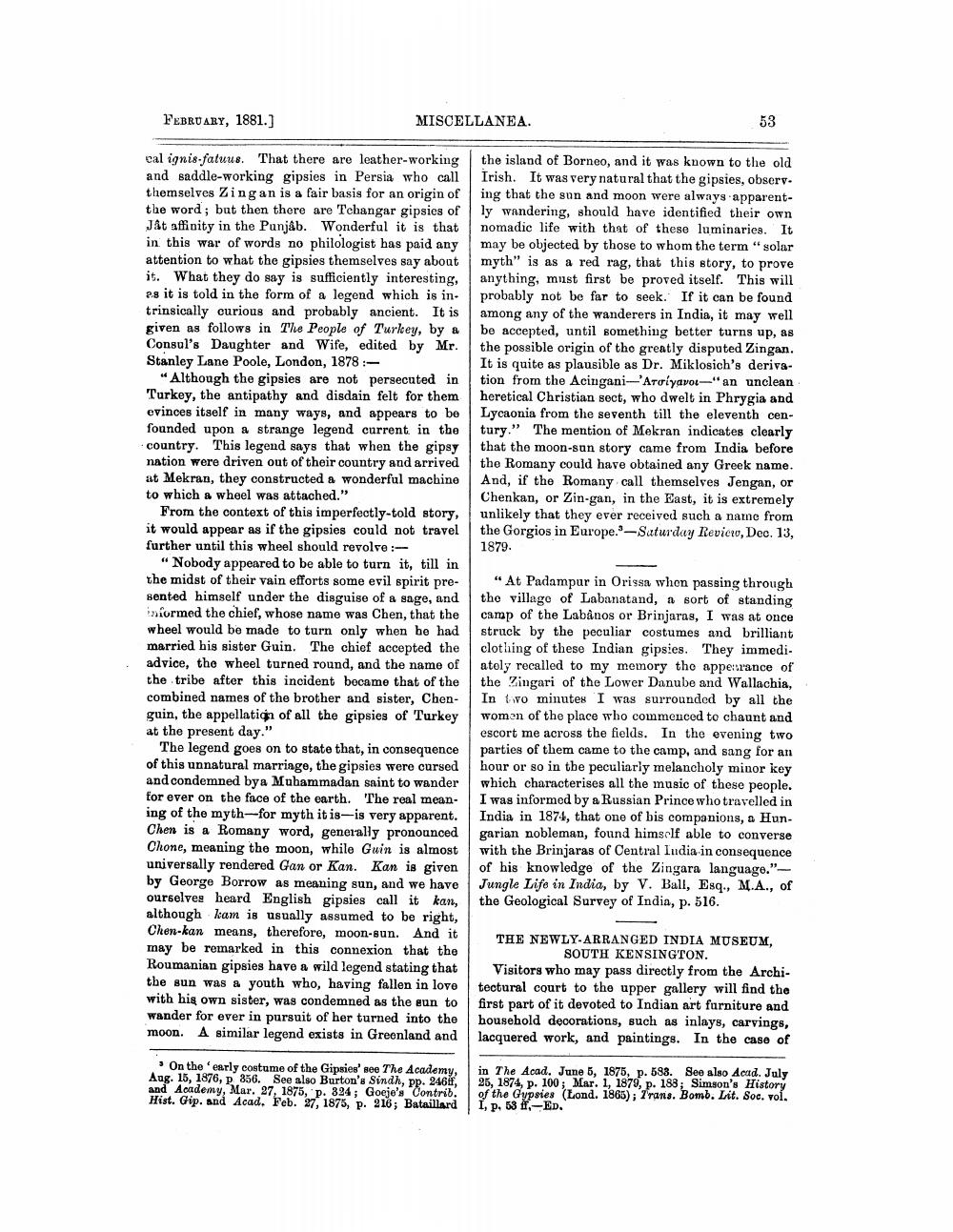________________
FEBRUARY, 1881.]
MISCELLANEA.
cal ignis-fatuus. That there are leather-working and saddle-working gipsies in Persia who call themselves Zing an is a fair basis for an origin of the word; but then there are Tchangar gipsies of Jât affinity in the Punjab. Wonderful it is that in this war of words no philologist has paid any attention to what the gipsies themselves say about it. What they do say is sufficiently interesting, es it is told in the form of a legend which is intrinsically curious and probably ancient. It is given as follows in The People of Turkey, by a Consul's Daughter and Wife, edited by Mr. Stanley Lane Poole, London, 1878:
"Although the gipsies are not persecuted in Turkey, the antipathy and disdain felt for them evinces itself in many ways, and appears to be founded upon a strange legend current in the country. This legend says that when the gipsy nation were driven out of their country and arrived at Mekran, they constructed a wonderful machine to which a wheel was attached."
From the context of this imperfectly-told story, it would appear as if the gipsies could not travel further until this wheel should revolve:
"Nobody appeared to be able to turn it, till in the midst of their vain efforts some evil spirit presented himself under the disguise of a sage, and informed the chief, whose name was Chen, that the wheel would be made to turn only when he had married his sister Guin. The chief accepted the advice, the wheel turned round, and the name of the tribe after this incident became that of the combined names of the brother and sister, Chenguin, the appellation of all the gipsies of Turkey at the present day."
The legend goes on to state that, in consequence of this unnatural marriage, the gipsies were cursed and condemned bya Muhammadan saint to wander for ever on the face of the earth. The real meaning of the myth-for myth it is-is very apparent. Chen is a Romany word, generally pronounced Chone, meaning the moon, while Guin is almost universally rendered Gan or Kan. Kan is given by George Borrow as meaning sun, and we have ourselves heard English gipsies call it kan, although kam is usually assumed to be right, Chen-kan means, therefore, moon-sun. And it may be remarked in this connexion that the Roumanian gipsies have a wild legend stating that the sun was a youth who, having fallen in love with his own sister, was condemned as the sun to wander for ever in pursuit of her turned into the moon. A similar legend exists in Greenland and
On the early costume of the Gipsies' see The Academy, Aug. 15, 1876, p 356. See also Burton's Sindh, pp. 246f, and Academy, Mar. 27, 1875, p. 324; Goeje's Contrib. Hist. Gip. and Acad. Feb. 27, 1875, p. 216; Bataillard
53
the island of Borneo, and it was known to the old Irish. It was very natural that the gipsies, observ. ing that the sun and moon were always apparently wandering, should have identified their own nomadic life with that of these luminaries. It may be objected by those to whom the term "solar myth" is as a red rag, that this story, to prove anything, must first be proved itself. This will probably not be far to seek. If it can be found among any of the wanderers in India, it may well be accepted, until something better turns up, as the possible origin of the greatly disputed Zingan. It is quite as plausible as Dr. Miklosich's derivation from the Acingani-'Arariyavo-"an unclean heretical Christian sect, who dwelt in Phrygia and Lycaonia from the seventh till the eleventh century." The mention of Mekran indicates clearly that the moon-sun story came from India before the Romany could have obtained any Greek name. And, if the Romany call themselves Jengan, or Chenkan, or Zin-gan, in the East, it is extremely unlikely that they ever received such a name from the Gorgios in Europe."-Saturday Review, Dec. 13,
1879.
"At Padampur in Orissa when passing through the village of Labanatand, a sort of standing camp of the Labanos or Brinjaras, I was at once struck by the peculiar costumes and brilliant clothing of these Indian gipsies. They immediatoly recalled to my memory the appearance of the Zingari of the Lower Danube and Wallachia, In two minutes I was surrounded by all the women of the place who commenced to chaunt and escort me across the fields. In the evening two parties of them came to the camp, and sang for an hour or so in the peculiarly melancholy minor key which characterises all the music of these people. I was informed by a Russian Prince who travelled in India in 1874, that one of his companions, a Hungarian nobleman, found himself able to converse with the Brinjaras of Central India in consequence of his knowledge of the Zingara language."Jungle Life in India, by V. Ball, Esq., M.A., of the Geological Survey of India, p. 516.
THE NEWLY-ARRANGED INDIA MUSEUM, SOUTH KENSINGTON.
Visitors who may pass directly from the Architectural court to the upper gallery will find the first part of it devoted to Indian art furniture and household decorations, such as inlays, carvings, lacquered work, and paintings. In the case of
in The Acad. June 5, 1875, p. 588. See also Acad. July 25, 1874, p. 100; Mar. 1, 1879, p. 188; Simson's History of the Gypsies (Lond. 1865); Trans. Bomb. Lit. Soc. vol. I, p. 53 -ED.




